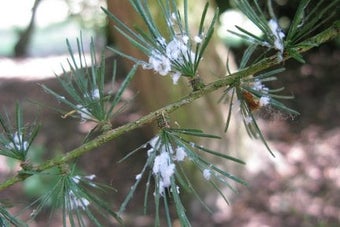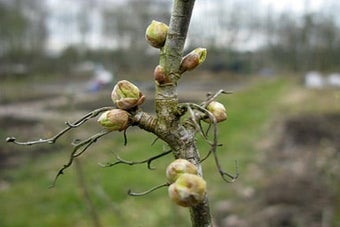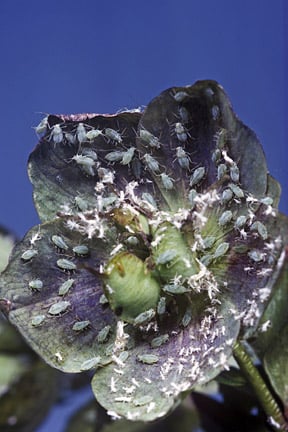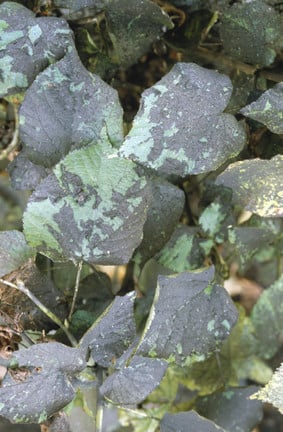
Quick facts
Common name - Conifer aphids (various species)
Plants affected - Various conifers
Main symptoms - Honeydew and sooty mould, dieback
Caused by - Aphids
Timing - All year
What are conifer aphids?
Aphids are sap-sucking true bugs. They range in size from 1 to 7 mm (¼ in or less) long. Some aphids are known as greenfly or blackfly, but there are species that are yellow, pink, white or mottled. There are more than 500 aphid species in Britain. Some feed on only one or two plant species, but others can be found on a wide range of plant hosts. Many have lifecycles that involve more than one host plant. Almost any plant can be a host to aphids, including ornamentals, vegetables, fruits, greenhouse plants and houseplants. More information on aphids.
Several species of aphid feed on conifers, these populations can result in the presence of sticky honeydew and sooty mould and in some cases dieback. Closely related adelgids can also be found on some conifers, these insects are often covered in a white wax or cause galls.
Symptoms
Each species of conifer aphid has a restricted host range and specific symptoms. Some of the conifer aphids frequently encountered in gardens are listed below.
Note: When searching for aphids, it is easy to confuse them with harmless insects known as psocids or barklice. These aphid-sized insects, may be winged or wingless, are generally brownish-white in colour. They feed on algae and fungal spores and may be abundant on trees affected by sooty mould. They run rapidly over the foliage and stems, unlike slow-moving aphids. Adelgids are usually either associated with galling or are covered in a white waxy substance.
Green spruce aphid (Elatobium abietinum): A small dark green aphid (1.5-1.8 mm long) with red eyes. It feeds on spruces, Picea species, especially P. abies (Norway spruce or Christmas tree), P. sitchensis (Sitka spruce) and P. pungens (blue spruce). It is unusual amongst aphids in that it is active during from autumn to spring. It can be found on spruce throughout the year but the summer months are spent as non-feeding nymphs. These start to mature during August and numbers can gradually build over the following six months. The green spruce aphid is favoured by mild winters which may result in damaging population levels occurring by late winter-early spring. The old foliage develops a pale mottled discolouration and many of these needles fall from the tree during the spring. This species produces honeydew and the resulting sooty mould is often noticed on stem joints. New growth in the spring is unaffected and its bright green appearance contrasts strongly with the discoloured and sparsely foliated older stems.
Juniper aphid (Cinara fresai): This species is of North American origin but is now widespread on Juniperus species in gardens in southern England. It is a large aphid (2.2-4.2 mm long) which varies in colour from pinkish-grey to brownish-grey. The dorsal surface of the body is marked by a darker inverted V towards the head end. It can form dense colonies on the younger shoots and is found from May to October. This species produces honeydew and the resulting sooty mould is often noticed on stems and foliage. Large populations can result in dieback of shoots or even the death of plants. The cultivar 'Skyrocket' is particularly susceptible.
Cypress aphid (Cinara cupressivora): This aphid feeds on Cupressus species especially C. macrocarpa, Thuja occidentalis, Chamaecyparis lawsoniana and x Cuprocyparis leylandii. It is 1.8-1.9mm long and yellowish-brown although it appears greyish due to a dense coating of fine hairs. There is a dark stripe running down either side of the upper body, particularly at the head end. It is active from May to November but are most noticable during the early summer. Small colonies tend to develop at the bases of the green shoots, which often become blackened by sooty moulds growing on honeydew excreted by the aphids. Affected shoots usually become yellowish-brown and die back in midsummer. The lower parts of hedges are often more severely affected than the upper branches.
Cedar aphid (Cedrobium laportei): A small aphid (1.5-2 mm) long and greyish-brown with a paler mid-dorsal stripe running from the head end. It feeds on cedars including Cedrus atlantica, C. deodora and C. libani. Dense colonies can occur at the bases of the leaves during May and June, this can result in the affected leaves being shed. This aphid excretes large quantities of honeydew and sooty mould frequently develops, both on the tree and on the ground underneath.
Large cedar aphid (Cinara confinis): The largest populations occur in June-July but this aphid is active on Cedrus and Abies species from March to October. A very large aphid at up to 7.8 mm long they are greenish black or dark brown with a double row of dark spots on the upper surface of the abdomen. The foliage can become sticky with honeydew and blackened by the growth of sooty moulds. It can become active in winter on Abies brought indoors for use as Christmas trees.
Black spruce bark aphid (Cinara piceae): The adult aphids are large (5-6 mm in length) and sometimes mistaken for spiders or beetles. The adult aphids are shiny black with reddish-brown legs, while the nymphs have duller greyish-black bodies. They suck sap from the bark of a wide range of spruce trees (Picea species) and may form dense colonies several feet across on the trunk. The aphid is active from April until the autumn with populations reaching a peak in late May and June. The trunk and branches can become heavily coated with honeydew and sooty mould. This aphid is often very local and large colonies are spectacular but infrequent.
Grey pine needle aphid (Schizolachnus pineti): Dense colonies of this 1.2-2.5 mm long aphid can occur on the undersides of the mature leaves of Scots pine and other Pinus species. The aphids are coated with a greyish-white wax and they are present from May until the autumn. Large populations may cause yellowing of the foliage.

Management
What should I do? Here are our top tips to your most common questions on managing aphids.
Should you remove aphids? Tolerate aphids where possible. It is usual to have some in a healthy, balanced garden. They are a vital food source for a wide range of wildlife in the garden.
Do aphids kill plants? Very rarely. Some aphids cause some leaf and bud distortion and affect plant vigour when numbers are high. Small populations of some species can cause browning on conifers. Some species can spread plant viruses and you might see some honeydew on which a harmless sooty mould can grow. This can be wiped off with a damp cloth. On established trees aphids can usually be considered part of the biodiversity they support, natural enemies will normally reduce numbers during summer
Do I have to control aphids? You don’t have to kill or control them. They are part of the biodiversity of gardens and a vital food source for other wildlife in your garden.
Should I use pesticides to control conifer aphids? No - The RHS recommends that you don't use pesticides. This is because most pesticides (including organic types) reduce biodiversity, including natural enemies, impact soil health and have wider adverse environmental effects. Here are some steps you can take to manage conifer aphids:
- Check susceptible conifers frequently from spring onwards so action can be taken before a damaging population has developed
- Encourage the natural enemies of aphids in your garden, such as ladybirds, ground beetles, hoverflies, parasitoid wasps and earwigs. In spring, aphid populations increase before the natural enemies are active in sufficient numbers – so if you wait a while, they’ll often give control
- Use finger and thumb to squash aphid colonies
- Some natural enemies of aphids can be purchased as biological control for use in greenhouses, including hoverfly larvae, lacewing larvae and several parasitoid wasps. More information about these can be found on the ‘aphid predators’ page































